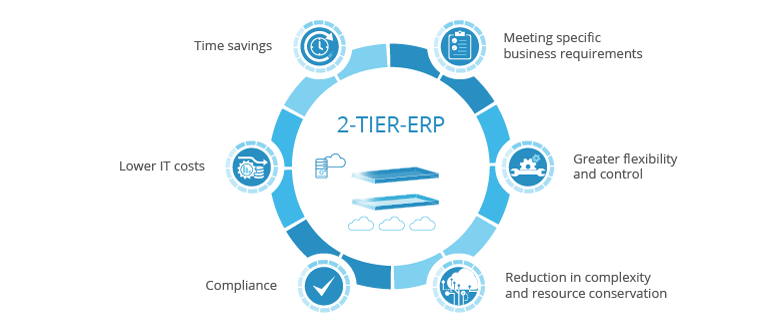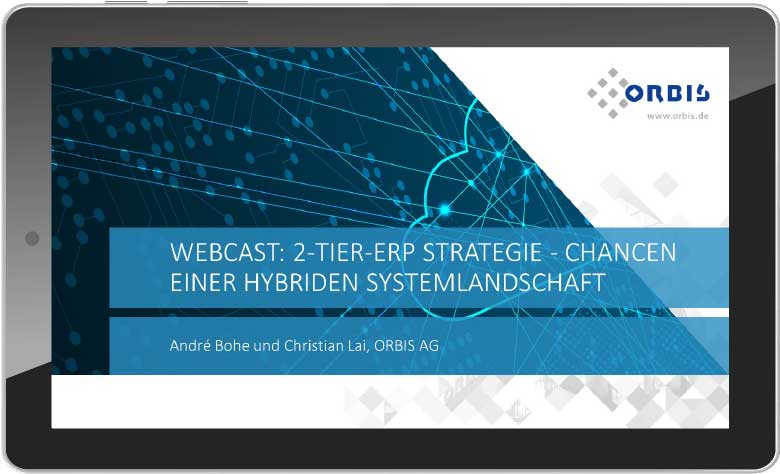Two-tier ERP strategy: hybrid system landscape with SAP
Simple organization with double the impact: simplify the management of your different business units with the two-tier ERP strategy and ORBIS.
Are you expanding faster than you can adapt your software landscape? Does the functional scope and complexity of your existing enterprise resource planning software exceed the requirements of your smaller organizations? Is the cost, effort, and complexity of managing your existing ERP system ever increasing?
If you answered yes to one or more of these questions, a two-tier approach could be the right choice for you. Organizations that want to pursue their Industry 4.0 strategy while benefiting from the advantages of flexible and effective collaboration are increasingly opting to develop a hybrid approach with one or more ERP subsystem (two-tier ERP architecture or N-tier architecture).
This approach to working with distributed systems offers our customers and you the opportunity to retain existing ERP software and also link it to a cloud-based application such as S/4HANA Cloud. Your business activities are effective yet flexible as a result.
The advantages of a two-tier ERP
The diagram shows the benefits of a two-tier ERP architecture.

Flexible and scalable
Respond quickly and flexibly to constantly changing market and customer requirements – and in a way that is tailored to the specific needs of local organizational units, even after initial implementation.
Simple and resource saving
Streamline and automate your processes through an intuitive user interface, a focus on best practices, and the reuse of solution templates.
Time and cost saving
The integration of standardized systems with industry-specific functionalities allows you to implement your processes in a more targeted manner, which saves both time and money.
Legally compliant
Maintain an overview of the current compliance guidelines for your industry.
What does the two-tier architecture of an ERP system involve?
Unification instead of island landscapes: a two-tier ERP architecture consists of two different but interconnected layers. This allows you to manage different business units within a corporate organization in a way that is efficient and straightforward.
An example: If a manufacturing company decides to implement a separate ERP application for its headquarters (Tier 1 ERP) and another one for its subsidiaries (Tier 2 ERP), it has a two-tier ERP with a two-tier architecture.
This second system usually costs a lot less, as it doesn't involve as much implementation work. Implementing this “small” but comprehensive ERP version is less time-consuming and cost-intensive than introducing a completely new, all-encompassing ERP application for all areas of the company. The diagram below shows the general structure of such a two-tier ERP architecture within a corporate organization, with each tier defined.

What is a Tier 1 ERP system?
The existing IT architecture (Tier 1 ERP) forms the basis. It can be used as either a server-based on-premise option or as a cloud-based version to support the complex functionalities found at company headquarters and production sites.
- Ideal for large organizations with complex structures and international locations (large enterprises)
- Covers an extensive range of functions
- Tier 1 is individually tailored to the highly complex requirements and needs of business headquarters
- Focus on core functionalities such as finance, human resources, and procurement
What is a Tier 2 ERP system?
Cloud-based Tier 2 is a type of simplified software system for the management of smaller organizational units (diagram: subsidiary 1, subsidiary 2, subsidiary 3) such as subsidiaries, international locations, and start-ups. The advantage of a Tier 2 ERP: it's much faster and easier to implement than a completely new, all-encompassing ERP application, but offers just as much opportunity for flexibility and individuality thanks to cloud technology.
- Streamlined range of functions
- More cost-effective and resource-efficient than a comparable, standardized Tier 1 ERP solution
- Tier 2 can be used at different levels within an organization
- Usable by different business areas
- Can be adapted to a company's specific architecture
Which customers is the two-tier ERP strategy suitable for?
No matter how complex your company's infrastructure and business processes are, a two-tier ERP gives you the flexibility you need to simplify and adapt them to fit your specific needs thanks to two-tier architecture. Two-tier ERPs make sense for companies falling into the following categories:
- Organizations with smaller, less complex subsidiaries and/or international units that are active in a different sector than the company headquarters
- New companies that have become part of the organization through a merger, acquisition or similar
- Customers who want to take advantage of a two-tier architecture, while continuing to use the existing Tier 1 system for certain business functions or processes
- Companies looking to modernize but who also want to maintain their current system landscape
- Organizations that want to combine the benefits of a classic on-premise system with those of a cloud-based ERP system and implement these at different levels within their organization
More information in our webinar on demand

Two-tier ERP strategy – opportunities through a hybrid system landscape
What exactly does a two-tier ERP strategy involving an on-premise system and S/4HANA Cloud look like? We explain and share further details!
This webinar on demand is only available in German.
Two-tier ERP with ORBIS and SAP S/4HANA Cloud
We use the S/4HANA ERP software from SAP to provide an independent and flexible solution for your digital transformation. As a cloud-based software-as-a-service (SaaS) solution, the two-tier ERP is scalable to your individual needs while remaining cost-effective. Contact us and let's talk about how we can develop a two-tier ERP strategy together based on the current SAP portfolio.
As SAP ERP specialists, we get the most out of your business processes with SAP S/4HANA
Need your S/4HANA transformation to be quick and risk-free? This not only requires expertise in SAP but also in your relevant industry. We have both and specialize in the processes used by mid-size industrial businesses.
What our SAP S/4HANA consulting service provides:
- Needs-based sizing of the system infrastructure and SAP system landscapes
- Scalable landscape design
- Risk-compliant availability solution
- Modular security solutions
- End-to-end recovery concepts
- Seamless integration into your specific IT landscape

I'm here to help you
Christian Lai (Senior Account Manager SAP)
Tel.: +49 681 9924 209
E-Mail: christian.lai(at)orbis.de





